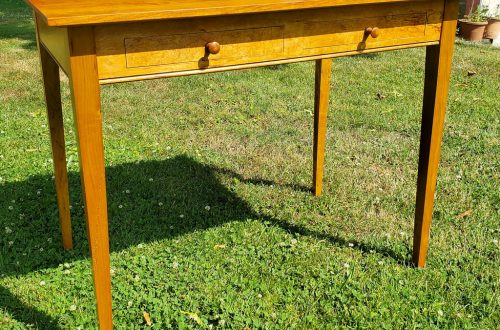Despite the lack of entries, there has still been progress!
I slacked-off on writing here for a little while. I enjoy it, but started to get a backlog of stuff I wanted to write about, then just let it all accumulate until I was overwhelemed just thinking about writing. Blah. In the meantime, even more stuff has happened. Yay stuff!
The latest set of projects has been all over the map in terms of impact. First (and possibly most noticeable) has been the new front storm door. I think I started this back in May or June, but progress was slow. I finally moved the door (in pieces–I couldn’t actually assemble it and move it from the workshop) from my parents’ basement to our home in mid-August, shortly after we got back from vacation. This afforded me the opportunity to work on it at my leisure, and to do the final test fittings necessary to complete assembly. During the last week and a half of August, I was able to assemble the door, plane to final fit, put finish/sealer on the door, install the hardware, and finally hang the door. I only have the screen panels in the door for now, as I need to purchase some additional lumber to build the winter panels.
Jenny and I have also been working in the living room as we have time. Hot weather has slowed us down, but we’re still working at it. I’ve started to strip paint from some of the woodwork. The walls are mostly ready to patch and prime. The ceiling is mostly ready to sand, patch and prime. We’re making progress. I’ve had a product called Citrustrip recommended to me for stripping some of the woodwork. It is supposed to be safe and environmentally friendly. I’m considering getting some to see how it works. I don’t mind the heat gun method, but it looks like I’ll have a lot of old finish to clean before we can sand and re-finish. The easiest way to clean-off that finish is probably with some solvent (this appears to be shellac, so the solvent would be denatured alcohol). That could get unfriendly. There is still a lot of woodwork left to go in the room, but I feel good about it now. Jenny and I can both see progress being made, and I think that makes both of us excited.
A third recent happening has been some electrical work. We had the main service entrance replaced/upgraded before we left for vacation. That had become necessary due to the deteriorating entrance cable, the small and fully-populated main panel, and the desire to get some additional capacity in our service while we could still do it easily. That part was pretty easy and painless, as we hired a contractor to do the work for us. He came highly recommended, and did a beautiful job. I’ve seen a lot of panels, and a lot of them have been pretty poor. This is a completely professional job, and this contractor went over and above what was necessary. Our neighbor is the electrical inspector, so he walked over to do the inspections and sticker everything appropriately. This got us ready to start doing some additional electrical work in the house.
This past weekend, I recruited my father (experienced electrician from “way back”), and we began the rewiring mission. I had a few initial priorities:
- New circuit for living room outlets.
- New lighting for future workshop area in the basement.
- Improved lighting for the laundry/storage areas in the basement.
- New utility circuits in the basement to handle the washing machine, a future dehumidifier, and the chest freezer that has been living at my parents’ house.
- A new utility circuit for the workshop area.
One of the big problems that I was running into while working in the living room was that the circuit feeding the living room outlets was quite overtaxed and overextended. It had half of the basement lights (the important half, of course), two-thirds of the first floor lights, most of the first floor receptacles, and at least one-third of the second floor receptacles, including the one that runs the air conditioner in the bedroom. Through experience, it became quite clear that we had a choice as to what we could run at the same time:
- Dining room lights, air conditioner, and fan in the living room.
- Air conditioner, fan, and shop-vac.
- Fan, shop-vac, and work lights (low-wattage setting on the halogens).
- Fan, heat gun.
As one might imagine, it was a bit difficult to work in the living room at night when it was warm outside, which comprised a good bit of our available time (and that bit of time continues to grow, as we start to get dark a little earlier every day). This could no longer be tolerated–we needed the fan for ventilation (especially when stripping paint), the lights to see what we were doing, the shop-vac to clean up our mess, and the heat gun to melt the infernal paint’s bond to the beautiful wood.
Fortunately for us, two of the outlets in the room are floor-mounted, so we could easily access those from the basement. Those were pretty easy to fish with new wire. There is a third outlet that is wall-mounted, but I believe that we can get new wire to that one pretty easily, too–that will have to be a project for the near future. We ran a new 20A circuit to feed those three outlets (though we only have the first two wired right now), and I replaced the one outdated old-style no-ground edison outlet with a standard grounded three-prong edison (I had replaced the other one when one of the cats had an accident over it, destroying the old ungrounded edison outlet).
Next, we began working on new lighting for the future workshop area in the basement. I decided that I wanted to go the “safe” route for the basement outlets, since the basement can sometimes be a damp place, so we bought GFI breakers for the new basement outlets. I figured that we would wire all of these circuits as 20A circuits, since we had the correct capacity wiring and might, in the future, want to run other things off of some of these circuits. We pulled power from the panel to a central box, where we ran a switch leg over to a new box on the wall for a wall switch. From the central box, we wired two duplex outlets, one on each side of a shelf wall dividing the two workshop areas. I chose fluorescent fixtures that used two T8-style tubes in each fixture. The T8 tubes are more energy efficient than standard tubes, and are still quite bright. As an added bonus, the new ballasts are instant-on, so there is practically no flicker and a very short warm-up window for the tubes to get to full brightness. We put two fixtures on each side of the dividing wall. These fixtures happen to be plug-in instead of direct-wire, which is why we went with the duplex outlets to feed them. As an added bonus, using the outlets will make adding any additional fixtures easy. We had issues when we went to activate the circuit, though. First, we had an issue with the switch leg that was easily solved. Then, we ran into an issue that we spent literally probably two hours trying to trace. The GFI breaker kept tripping, and we couldn’t figure out why. After re-reading the directions for the umpteenth time (we had never installed a GFI breaker) we noticed the one detail that we had missed in all of our readings: Neutral for the circuit had to be connected to the breaker, NOT the neutral buss bar. Oops. One quick wire move, and all was happy again.
After we got through that, we decided to call it a day. We were already pretty tired, dirty, and we were getting tired of working with our hands over our heads. We’ll probably finish up some of the wiring work this weekend.
On top of all of this, I also started to move the workshop to the house. Finally. I also started to work on building a router table, which is going to be necessary for the next project: Wedding clocks.
Until next time…
jonathan


